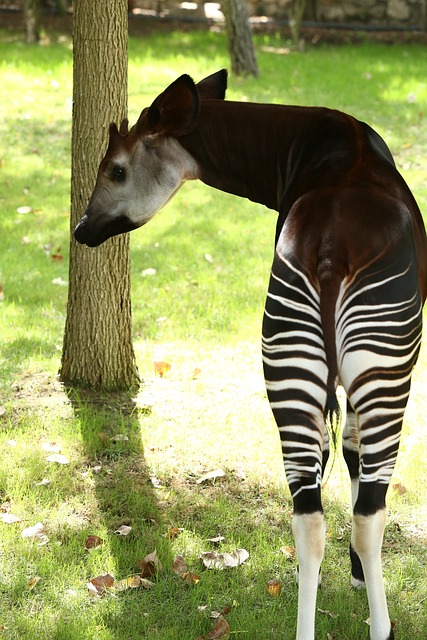
The Okapi(Okapia johnstoni), also known as; Congolese Giraffe, Forest Giraffe, And Zebra Giraffe, is an African mammal that is classified in order Artiodactyla, and family Giraffidae.
Physical Characteristics
Okapis are reddish-brown to chocolate-brown in color, with white horizontal stripes on their legs. Males have protuberances on their heads called ossicones.
Ossicones are hardened cartilage covered by skin and hair. Okapis have a long tongue that is about 40 centimeters(1’4”) which helps them to reach some of the vegetation they eat. Okapis weigh 267 kilograms(589 pounds) on average and are about 1.5 meters(4’11”) tall at the shoulder. Okapis are 2.2 meters(7’3”) long on average.
| Genus | Okapia |
| Species | O. johnstoni |
| Binomial Name | Okapia johnstoni |
| Length | 1.5-2.2m(4’11”-7’3”) |
| Shoulder Height | About 1.5m(4’11”) |
| Weight | 200-350kg(441-772 pounds) |
| IUCN Status | Endangered |
Range And Habitat
Okapis live in the Democratic republic Of The Congo where they inhabit rainforests.
Breeding
An Okapi mother gives birth to typically 1 calf after a gestation period of 14 to 16 months. A newborn calf can weigh up to 30 kilograms(66 pounds). Calves can stand within 30 minutes of birth. Female Okapis reach sexual maturity at about 1.5 years old and males at 2 years old.
Diet
Okapis eat buds, fruits, fungi, grass, and leaves. They also eat clay and charcoal to help digest the toxins in some of the vegetation they eat.
Predators
The Leopard(Panthera pardus) is the main natural predator of the Okapi.
Fun Facts
An Okapi’s ears can rotate independently, so it can listen for sounds both in front and behind.
Okapis can live for up to 30 years.
The Okapi Conservation Project is an organization dedicated to conserving the Okapi.
Approximately 100 Okapis are in accredited AZA(Association of Zoos and Aquariums) zoos.
In 1937, the Bronx Zoo became the first zoo in North America to acquire an Okapi.
The San Diego Zoo has exhibited Okapis since 1956, and their first Okapi calf was born in 1962.
